APJ ABDUL KALAM TECHNOLOGICAL UNIVERSITY Previous Years Question Paper & Answer
Semester : S1 and S2
Subject : INTRODUCTION TO SUSTAINABLE ENGINEERING
Year : 2018
Term : JULY
Branch : MECHANICAL ENGINEERING
Scheme : 2015 Full Time
Course Code : BE 103
Page:3
E 11106 = `
Case - 4
A beginning of the Green Building movement in India
The Cll-Sohrabji Godrej Green Business Centre (೮11-0066) GBC) is a unique and successful
model of public-private partnership between the Government of Andhra Pradesh, Pirojsha Godrej
Foundation and the Confederation of Indian Industry (CII), with the technical support of USAID.
The 1858m? building consists of an office building, a seminar hall and a Green Technology
Centre, displaying the latest and emerging green building materials and technologies in India.
The building was the first LEED Platinum-rated building for New Construction (NC) outside of
the US and a large number of visitors tour the building to view its green features annually.
According to the Indian Green Building Council, the CII-Godrej GBC building “marked the
beginning of the Green Building movement in India”.80% of the materials used in the building
were sourced within 500 miles from the project site. Most of the construction material contains
post-consumer and industrial waste as a raw material during the manufacturing process. Fly-ash
based bricks, glass, aluminium and ceramic tiles, which have post-consumer and industrial waste
were used in constructing the building to encourage usage of recycled content. Office furniture is
made of bagasse-based composite wood. More than 50% of the construction waste was recycled
within the building or sent to other sites and diverted from landfill.As the first well-publicized
green commercial building in India, the incremental cost was 18% higher than a conventional
building. However, the Indian Green Building Council asserts that green buildings are now being
delivered at an incremental cost of 6-8% in India and this initial incremental cost usually gets
paid back in 3 to 4 years.
oa
ವಯ ہے
Module IV
12 a) Which are the three primary green building rating systems in India? (3)
b) Name the post-consumer and industrial waste materials used for the construction (2)
ofCII-Godrej GBC building
c) What are the benefits achieved when recycled materials used for construction? (2)
d) Green buildings cost more than traditional buildings. Is it true for the ClIl-Godrej (3)
GBC building during its operative stage?
Case - 5
World’s Largest Solar Steam Cooking System at Tirumala, Andhra
The world’s largest solar steam cooking system has been installed by the Tirumala Tirupathi
Devasthanam (TTD) at Tirupathi in Andhra Pradesh. The system has a capacity to prepare food
for 15,000 people/day and employs automatic tracking solar dish concentrators, which convert
water into high pressure steam. The steam thus generated is being used for cooking purposes in
the kitchen of TTD. It has been hooked up with the existing boiler working on diesel so as to
make the system reliable under all climatic conditions. The system has been designed to generate
over 4000 kgs of steam/day at 180°C and 10 kg/sq.cm which is sufficient to cook two meals for
around 15,000 persons. It is modular in nature and consists of 106 automatic tracked parabolic
concentrators arranged in series and parallel combination, each of 9.2 sq. meter reflector area.
Each unit of concentrators is connected to a central steam pipeline going to the kitchen. The
system is made of indigenous components and the reflectors are of acrylic mirrors having
reflectivity over 75%. Its installation was completed during September 2002 and was inaugurated
م 110൦0൦0൦ 2002. The system is expected to save around 1,18,000 litres of diesel per year
valued at Rs. 2.3 million.
Module V
13 a) What type of solar technology is adopted at TTD? (2)
b) Give the features of the solar units used at TTD. (2)
c) What are the social, economical and environmental advantages gained through (3)
the utilisation of solar energy?
d) Show a schematic diagram of the solar units and the generation of steam that (3)
have been provided at TTD.
Page 3 of 4
